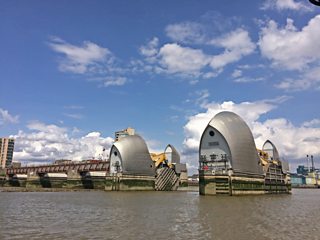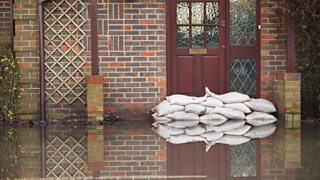Can we protect cities from rising seas?
Water is threatening to submerge cities around the world. Rising sea levels are starting to swamp low lying neighbourhoods, while extreme rainfall events are causing increasingly frequent and devastating flash flooding.
With 570 cities and 800 million people globally at risk from sea level rise, Radio 4’s Rare Earth asks how we can mitigate and adapt to protect their futures. Presenters Tom Heap and Helen Czerski explore solutions at every scale, from "rain gardens" in holes on London’s streets to a gigantic sea wall planned for Jakarta.
Here are some of their most interesting findings…

Sea levels could rise by a metre by 2100
“The sea level rise is coming… even if we stopped burning fossil fuels tomorrow,” Helen explains. And it’s not just caused by melting ice: when water warms up it expands, which pushes sea levels up even further.

Tom says that, “while a metre is close to the more extreme scenarios of climate change, half a metre is quite within where it looks like we could be going, even with a lot of adaptation. And that would be talking about flooding cities like New York, Houston, Lagos, Dakar, Bangkok, Venice, London.”
But the degree of sea level rise won’t be the same everywhere. Helen explains that in some areas the land is rising slowly over time, while in others it’s sinking. What’s more, the huge mass of ice around Antarctica means it attracts more water due to gravity, but when the ice melts the pull reduces and sea levels around the continent fall slightly.
93% of London’s flood defences will need to be upgraded
London is protected from flooding by the Thames Barrier. But Professor Emma Howard Boyd, author of the London Climate Resilience Review, says most of its surrounding defences – in the form of walls and embankments along the river Thames – need to be improved in the next 25 years.
She explains: “There's something like 120 kilometres where the defences need to be looked at. I think only 7% of that is fit for purpose in 2050, and it may be only 10 centimetres [too low] in some portions of those defences, but in others it's half a metre where we need to raise the defences to protect London.”
Preventing the capital being deluged by rising sea levels will cost an estimated £16 billion by 2100. This might sound like a lot, but it would protect over £300 billion of residential properties.
Filling holes with plants could prevent flash flooding
Extreme rainfall is a growing risk to London’s housing and infrastructure. In July 2021, a month’s worth of rain fell in a single afternoon. It caused flash flooding that forced a hospital to close, and affected 2,000 properties and 30 Tube stations.

One idea to address the risk of flash flooding involves repurposing the 160,000 holes that are dug across London each year for utilities and services. Emma says that filling them with plants instead of concrete could potentially “help London become more spongy”. She explains that this would create “rain gardens” that can “absorb water and hold water, and slow that water down before it hits the streets and causes flooding.”
New Orleans shows that plants could be the answer
In New Orleans, $14.5 billion has been spent repairing flood defences since Hurricane Katrina caused devastation in 2005. But the city still floods regularly. So, residents have started to do their bit to tackle it.
Dana Eness leads the Front Yard Initiative, which gives householders small grants to adapt their gardens so that they collect and contain more rainwater. She says: “We have to stop thinking of our pumping system as our first line of defence… and look at our own front yard… And that's very empowering.” Resident Al DuVernay tells Helen about the impact of the scheme: “Typically the street right here in front of my house will flood... I [now] have no water running off into the street because what we have is these terraced rain gardens… and we built the closed loop French drain.”
Parts of Jakarta are sinking by 25cm a year
The vast city of Jakarta, the soon-to-be-ex capital of Indonesia, was built on marshland. Areas of it are already under water or uninhabitable because of frequent flooding.

Jakarta is falling further partly because of the amount of groundwater that’s drawn up daily through wells across the city. As Helen explains, “it's almost incredible to think that people can take enough water out of wells to make the whole city sink significantly.”
In response, the government of Indonesia has decided to relocate the country’s capital. It’s also investing billions in an ambitious project to build a bird-shaped island and a 30-kilometre sea wall that will run across it, to protect Jakarta city.
Houses could be built to clean up easily after flooding
Professor Richard Dawson from Newcastle University says another solution could be to design homes that can cope better when flooding happens. “We can start to think about the materials we use for constructing our houses. Having tiled floors [so it’s] easier to wipe away the grime from flood water rather than replacing entire carpets. Raising our electrical systems so that they're a metre above the floor, rather than just 30 centimetres or so. “So, that would allow for not having to rewire huge swathes of property. And outside we can start to install small-scale barriers or just close down air vents when we hear that a flood might be imminent… trying to seal the water out, but also accepting that sometimes we might be overwhelmed.”
Listen to Rare Earth: How to Floodproof a City
Essential listening on Radio 4
-
![]()
The Artificial Human
Aleks Krotoski and Kevin Fong answer the questions we're all asking about AI.
-
![]()
The Planet Earth Podcast
Exclusive insights from the acclaimed natural history storytellers that brought us the Planet Earth series.
-
![]()
The Cows are Mad
Science has still failed to definitively answer two major questions about mad cow disease - where did it come from and how did humans get it?
-
![]()
39 Ways to Save the Planet
39 ideas to relieve the stress that climate change is exerting on the planet.




